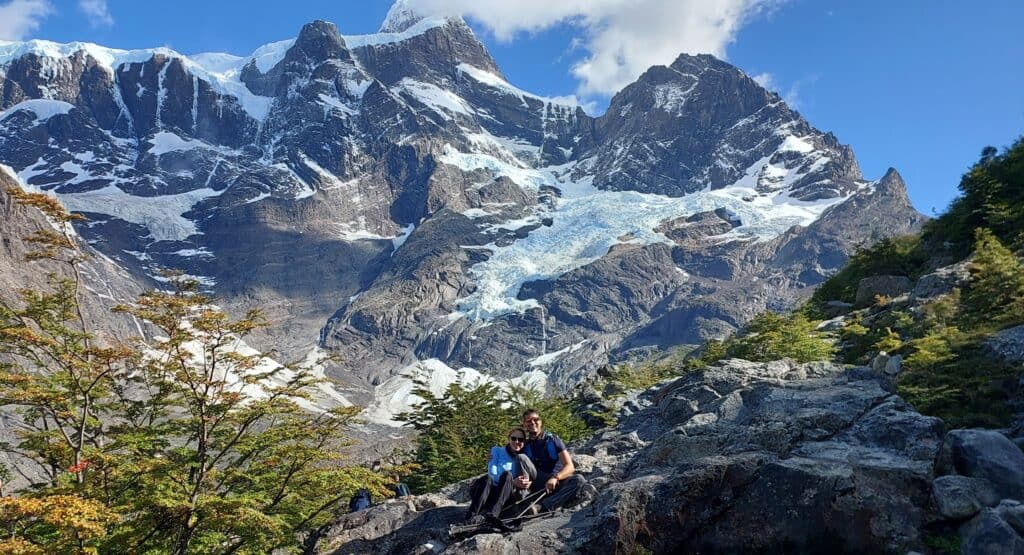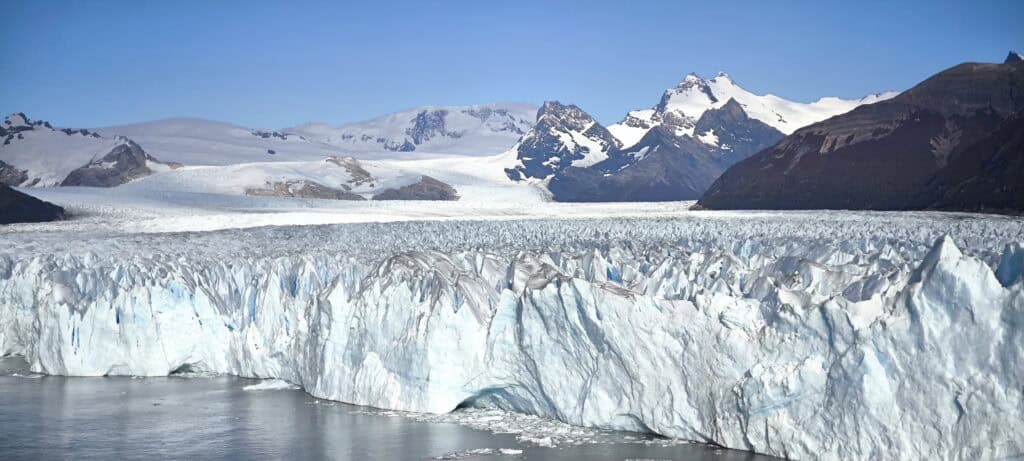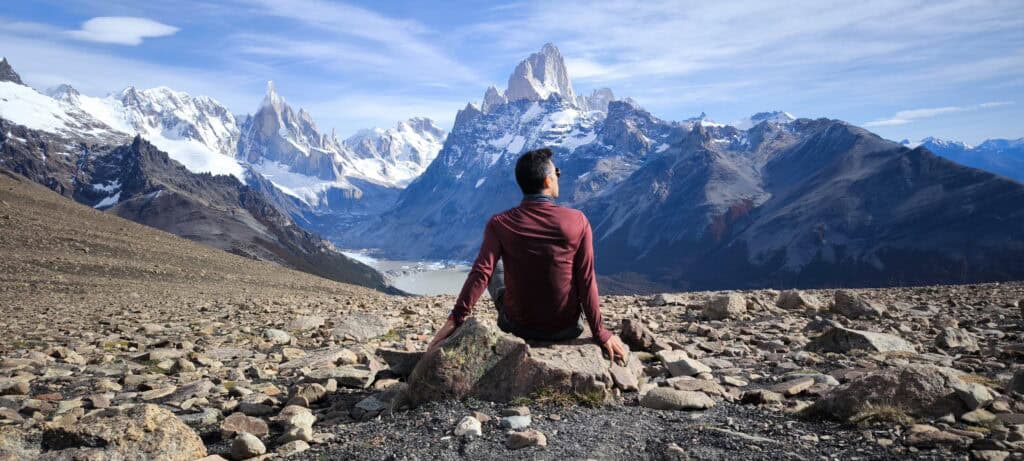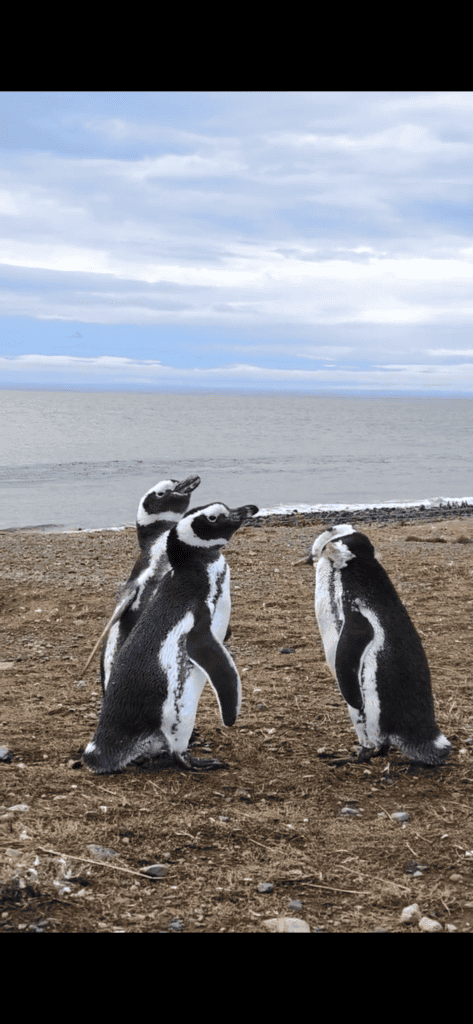One Month in Patagonia Itinerary – The Ultimate Southern Adventure
If you’re thinking about spending a month in Patagonia—do it. It’s wild, windy, and full of mountains that look like paintings. It’s hands-down one of the most incredible places I’ve ever visited.
We spent one full month exploring Patagonia’s Chilean and Argentinian sides, and our Patagonia Itinerary was absolutely perfect. Enough time for the iconic hikes, time to rest and recover, and space to just be in one of the world’s most remote and beautiful corners.
Here’s exactly how we did it:
- Day 1–2: Puerto Natales (Arrival + Gear Up)
- Day 3–10: The O Trek in Torres del Paine
- Day 11–12: Puerto Natales (Recovery Mode)
- Day 13–17: El Calafate
- Day 18–24: El Chaltén
- Day 25–27: Punta Arenas
- Day 28: Return to Puerto Natales
Day 1–2: Puerto Natales (Arrival + Gear Up)
We started (and ended) our Patagonia itinerary loop in Puerto Natales, the quiet little town that serves as the jumping-off point for Torres del Paine. Give yourself two days here before the big trek—not just for gear check and snack runs, but also to soak up some calm before the wild.
Go for a walk along the fjord and watch the sunset over dinner at La Escondida.

Day 3–10: The O Trek in Torres del Paine
This was the highlight of the whole trip. The O Circuit is a full loop around Torres del Paine National Park, and it’s truly next-level. For 8 days, we hiked through forests, over mountain passes, past glaciers, and along turquoise rivers, carrying everything we needed on our backs.
The John Gardner Pass was brutal and breathtaking, and seeing the Grey Glacier stretch endlessly into the horizon is something I’ll never forget. You’ll need to book your campsites in advance (it’s mandatory and fill up even a year in advance), and you’ll want to pack light but smart.
Compared to the W Trek, the O is quieter, longer, and more remote. It’s a real adventure; if you’re up for the challenge, it’s 100% worth it.
Especially for this part of the journey, make sure that you have good insurance coverage. Every time we travel, we rely on SafetyWing’s Nomad Insurance. I love how it covers unexpected medical needs, protects my gear, and even helps with travel delays. We use it on all our longer trips for coverage. The flexibility and price make it a no-brainer. If you want the same peace of mind, check it out SafetyWing here.
Day 11–12: Puerto Natales (Recovery Mode)
After the O, we returned to Puerto Natales for two very important things: laundry and food. The second time around, we were smarter—we booked a place with a kitchen, stocked up at the grocery store, and took it slow.
Go get your legs back with another stroll along the waterfront. Sit in a café. Do nothing for a day or two. You’ve earned it.

Day 13–17: El Calafate
Next stop: Argentina. We rented a car, which required an international permit to cross the border, which is checked throughly. The crossing into Argentina did not include a food check but the crossing back into Chile was very strict on any fresh food in your car.
We made our way to El Calafate, home to one of the most surreal sights in all of Patagonia—the Perito Moreno Glacier.
This glacier moves—like, you can actually hear it groaning and see chunks falling into the water. It’s massive, humbling, and 100% lives up to the hype. You can walk along the viewing platforms or book a boat trip to get up close.
The rest of the town is laid-back, with cozy cafés, a nice little lagoon walk, and a few solid restaurants. Five days was a good balance of activity and downtime before our next hiking chapter.
Day 18–24: El Chaltén
El Chaltén is a dream for hikers. It’s tiny, rugged, and surrounded by jagged peaks. We stayed for a full week and were so glad we did because the weather here is unpredictable. Some days, it poured sideways; others were crystal clear—and those were the days we hit the trails.
The big three hikes:
- Laguna de los Tres (Fitz Roy) – Save this for your best weather day. It’s tough but jaw-dropping.
- Laguna Torre – A little easier, with an incredible view of Cerro Torre and floating icebergs.
- Loma del Pliegue Tumbado – The most underrated hike in town with 360° panoramic views.
Pro tip: Stock up on groceries in El Calafate before you come. The grocery stores in El Chaltén are rough. We stayed in a place with a kitchen, which saved us a ton. El Chalten is very expensive since it is a town mostly for tourists.

Day 25–27: Punta Arenas
We closed the loop by heading back to Chile, stopping for a few days in Punta Arenas before flying home. When crossing back into Chile, make sure you do not have any fresh food in your car (fruit, veggies, eggs, etc.); they will require you to throw it all away at the border.
The town is surprisingly charming, and there’s more to do here than you’d expect.
We visited the Nao Victoria Museum to climb around life-sized replica ships, checked out the cemetery (yes, really—it’s famous for a reason), and ate our weight in seafood and Chilean craft beer.
But the real highlight? The penguins on Isla Magdalena.
Even though it was the end of the season, we still got to walk among thousands of Magellanic penguins as they started to gather courage and head out to sea. It was one of those wildlife experiences that feels like a dream. Definitely worth the early wake-up and cold wind. We booked our Punta Arena Penguins tour with Solo Expediciones, which I would absolutely recommend. The tour starts at 6:30 a.m. in the center of Punta Arenas. The bus will take you to the port, where a private enclosed boat will take you to Isla Magdalena.

Day 28: Return to Puerto Natales
We drove back to Puerto Natales for one last night before flying home. That final sunset over the water hit differently—tired legs, full heart, and a head full of mountain memories.
Final Thoughts on One Month in Patagonia Itinerary
A month in Patagonia itinerary felt like the perfect amount of time. Long enough to see it slowly, wait out bad weather, challenge yourself with a real trek, and recover from it. We had space for adventure and quiet.
Here’s what made it work:
- A balance of hiking and rest days
- Stocking up on groceries and gas whenever possible
- Booking key things in advance (O Trek campsites and rental car)
- Staying flexible with the weather
Patagonia isn’t always easy, but it’s always worth it. If you’re thinking about going—go. You won’t come back the same.
